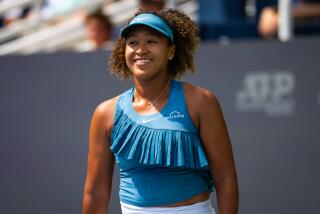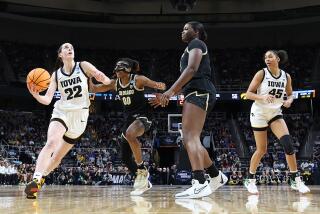Austin Remains Quite a Winner
- Share via
When Mrs. Scott Holt of Rolling Hills Estates steps up to be inducted into the Southern California Tennis Hall of Fame on Saturday night at the Riviera Country Club, she will be more than 20 years removed from her days of athletic glory.
For Tracy Austin, they have been a good 20 years.
She is a wife and mom now. She and husband Scott, a successful businessman in commercial real estate, have three boys. Dylan, 9, played in a tennis tournament this week, and was headed off to play in a baseball game Monday afternoon. Brandon, 7, also has started to swing the racket and Sean, 4, is trying that too, now that he has potty-training mastered.
Most days at home consist of mom and the boys, running errands, running to sports events and, well, just running.
“I am the chauffeur,” Austin says.
She keeps her hand in tennis with assignments for the BBC and USA Network that take her away from home perhaps five or six weeks a year. And despite the injuries that prematurely knocked her off the tour at the peak of her career, she still plays tennis at least three times a week, even though, at age 42, she is nowhere near the pigtailed little dynamo who weighed 89 pounds when she won her first pro tournament at age 14. No, like all of us, age has affected Austin, who has bulked up to about 105 now.
Despite carrying all that extra weight, she managed to squeeze in a little tournament action recently, between stints in the BBC booth at Wimbledon. Playing in the seniors event there, she and Jana Novotna won the women’s doubles title.
“It was good, winning that,” she says. “I liked that.”
In her life after tennis, Austin has managed to achieve the same thing she achieved during her life in tennis.
Balance.
“It’s all planned now, almost orchestrated, for these young players,” she says. “With me, it just happened.”
Her parents, Jeanne and George, who still live in the same house on the Palos Verdes Peninsula where they have lived in for 50 years, were working people, intent on raising five children, not five tennis stars. Dad was a computer scientist from MIT and mom ran the front desk of the Jack Kramer Tennis Club six days a week, starting two weeks after the facility was opened in December 1962. Mom was there, the courts were there, and all five kids played tennis, eventually at a high level.
But none higher than Tracy, who at age 10 had already won the national girls’ 12 title.
The rapid road to fame began early in 1977, when the Austin family got a phone call from Portland, Ore., where older brother Jeff was playing in an indoor tournament. He told his parents that Portland was also playing host to a women’s qualifying event for a satellite tour known then as the Avon Futures. Why not come on up, watch me play, and bring Tracy along to give this qualifying event a try, Jeff said.
Tracy soon learned that all she had to do was get to the semifinals to qualify for the Avon event, and when she beat Mary Carillo in the quarterfinals, she had made the main event. Austin jokes that Carillo, now a network tennis broadcaster, takes credit for making her career.
“I got to the semis of the Avon event,” Austin says, “then I had to fly back to go to school for a day. But I flew back up, won the semis and beat Stacy Margolin in the final.”
At 14 years 28 days, Tracy Austin had become the youngest tennis player to win a pro event.
Later that year, she entered the U.S. Open as an unseeded amateur, made it all the way to the quarterfinals before losing, and got a phone call in the Forest Hills locker room from President Carter.
“I can’t imagine what I said, if I said anything at all,” Austin says. “I was 14, and so shy.”
By then, she was in the top 10 in the world, had won the national 14s and 18s and was a quarterfinalist at the U.S. Open. But since she hadn’t won the girls’ 16 title, she went back to the junior nationals and won the 16s and 18s.
“Things were so different then,” she says. “Can you imagine anybody doing that now? These kids can’t wait to get out of the juniors now. You can almost hear their sighs of relief.”
By 1979, Tracy Austin was up to around 92 pounds, and was ready to take over the tennis world. She beat Chris Evert in the U.S. Open final, 6-4, 6-3, and became the youngest champion there, at 16 years 9 months.
Her brother Jeff, who had worked so hard to get her ready for that tournament, was back in UCLA law school. When she called him after the semifinals, he hadn’t even heard that she had won. She demanded he fly to New York for the final, which he did. When she won, she hurried through her interview sessions so that she and her mother could get Jeff back to the airport in time to make a flight that would get him back to school Monday morning. Once she got her brother delivered to the plane, she realized she hadn’t eaten in hours, so she did what any 16-year-old would do. She went to McDonald’s.
“I was still in my tennis dress,” she says. “Some people recognized me and looked at me kind of strangely.”
That U.S. Open win wasn’t the first time Austin had beaten Evert that year. In a semifinal of the Italian Open, an event just a notch below the Grand Slams in stature, she had ended Evert’s 125-match clay court winning streak, then took the title by beating Sylvia Hanika in the final.
Coming shortly after the Italian is the French, clay’s Grand Slam. Austin didn’t play.
“I wanted to get an ‘A’ in social studies,” she says, “so I had to get back.”
She got to the semifinals at Wimbledon in 1979 and ‘80, won the Wimbledon mixed doubles title with brother John in ‘81, got her ranking to No. 1, and won her second U.S. Open title in 1981, beating Martina Navratilova in a third-set tiebreaker in which Navratilova unraveled and double faulted at 1-6.
She was rapidly closing in on $2 million in career earnings in an era when prize money was, compared to now, a McDonald’s hamburger. Certainly, the days and years ahead would be all Chateaubriand.
But before she reached her 21st birthday, it had all but ended. She had a back injury that forced her to stop playing. She has tried several comebacks, including one two years after she was inducted into the International Tennis Hall of Fame, where she won a first-round match of the 1994 Australian Open. Nobody has gone into that Hall of Fame and then come back to win a match in a major tournament. And that was after her back problems were overshadowed by a serious knee injury she suffered in a near-fatal car crash in 1989.
But the balance in Tracy Austin’s life remains.
Now, she plays tennis mostly for fun and has started her children on the game with care.
“I only start them with friends,” she says. “It has to be fun.”
After some health problems, her mom is back playing tennis three days a week and her dad, who is in his 80s and stopped playing years ago, is what he always was.
“I can say it,” Austin says. “He is a computer nerd, and I love him to death.”
Saturday night will be flattering. Surrounded by people who still idolize her, the memories will rush back, the evening will have a glow. But soon, it will be time for that balance again, where the next trophy is still a work in progress.
Hall of Fame mom.
*
(BEGIN TEXT OF INFOBOX)
SCTA Hall of Fame
Five names will be added to the current 45 members of the Southern California Tennis Hall of Fame on Saturday night in a ceremony at Riviera Country Club. The hall, started in 1968, last held an induction ceremony in 2002. This year’s group:
TRACY AUSTIN: Two-time U.S. Open women’s champion, she was the youngest to win Open at 16 years 9 months in 1979.
GLENN BASSETT: UCLA men’s coach from 1967-93, he led Bruins to seven national titles and coached Jimmy Connors and Arthur Ashe (as an assistant).
BEVERLY BAKER FLEITZ: Former women’s No. 1, she reached the Wimbledon final in 1955 and won the Pacific Southwest four times.
PANCHO GONZALEZ: Legend from the men’s pro tour. Only one of the five who won’t be in attendance Saturday, he died of cancer in 1995.
PANCHO SEGURA: Winner of the U.S. Pro Championships from 1950-52, he guided early career of Connors and taught at Beverly Hills Tennis Club.
More to Read
Go beyond the scoreboard
Get the latest on L.A.'s teams in the daily Sports Report newsletter.
You may occasionally receive promotional content from the Los Angeles Times.











